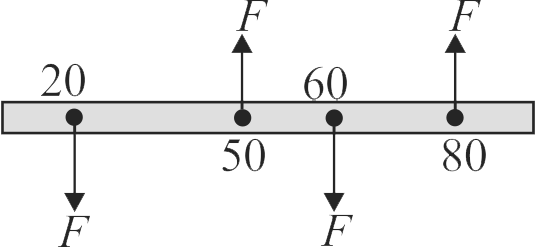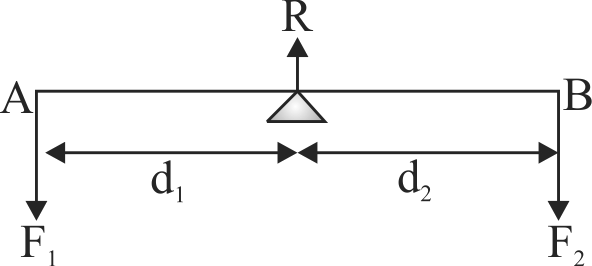366153
Four equal and parallel forces are acting on a rod of length \(100\,cm\), as shown in figure, at distances of \({20 {~cm}, 50 {~cm}, 60 {~cm}}\) and \(80\,cm\) respectively from one end of the rod. Under the influence of these forces, the rod (neglecting its weight)
366154
A lever system is shown in the figure below.
\({F_1}\) is usually some weight to be lifted and force
\({F_2}\) is effort applied to lift the load. Choose the correct statements.
I.
The ratio \(\frac{{{F_1}}}{{{F_2}}}\) is equal to mechanical advantage, i.e., \(MA = \frac{{{F_1}}}{{{F_2}}} = \frac{{{d_2}}}{{{d_1}}}\).
II.
If the effort arm \({d_2}\) is larger than the load arm, then a small effort can be used to lift a large load.
III.
At equilibrium load arm \( \times \) effort arm \( = \) load \( \times \) effort.
366156 A ladder rests against a frictionless vertical wall, with its upper end \(6\;\,m\) above the ground and the lower end \(4\,\;m\) away from the wall. The weight of the ladder is \(500\;N\) and its \(C.G\). at 1/ 3 rd distance from the lower end. Wall's reaction will be, (in newton):
366153
Four equal and parallel forces are acting on a rod of length \(100\,cm\), as shown in figure, at distances of \({20 {~cm}, 50 {~cm}, 60 {~cm}}\) and \(80\,cm\) respectively from one end of the rod. Under the influence of these forces, the rod (neglecting its weight)
366154
A lever system is shown in the figure below.
\({F_1}\) is usually some weight to be lifted and force
\({F_2}\) is effort applied to lift the load. Choose the correct statements.
I.
The ratio \(\frac{{{F_1}}}{{{F_2}}}\) is equal to mechanical advantage, i.e., \(MA = \frac{{{F_1}}}{{{F_2}}} = \frac{{{d_2}}}{{{d_1}}}\).
II.
If the effort arm \({d_2}\) is larger than the load arm, then a small effort can be used to lift a large load.
III.
At equilibrium load arm \( \times \) effort arm \( = \) load \( \times \) effort.
366156 A ladder rests against a frictionless vertical wall, with its upper end \(6\;\,m\) above the ground and the lower end \(4\,\;m\) away from the wall. The weight of the ladder is \(500\;N\) and its \(C.G\). at 1/ 3 rd distance from the lower end. Wall's reaction will be, (in newton):
366153
Four equal and parallel forces are acting on a rod of length \(100\,cm\), as shown in figure, at distances of \({20 {~cm}, 50 {~cm}, 60 {~cm}}\) and \(80\,cm\) respectively from one end of the rod. Under the influence of these forces, the rod (neglecting its weight)
366154
A lever system is shown in the figure below.
\({F_1}\) is usually some weight to be lifted and force
\({F_2}\) is effort applied to lift the load. Choose the correct statements.
I.
The ratio \(\frac{{{F_1}}}{{{F_2}}}\) is equal to mechanical advantage, i.e., \(MA = \frac{{{F_1}}}{{{F_2}}} = \frac{{{d_2}}}{{{d_1}}}\).
II.
If the effort arm \({d_2}\) is larger than the load arm, then a small effort can be used to lift a large load.
III.
At equilibrium load arm \( \times \) effort arm \( = \) load \( \times \) effort.
366156 A ladder rests against a frictionless vertical wall, with its upper end \(6\;\,m\) above the ground and the lower end \(4\,\;m\) away from the wall. The weight of the ladder is \(500\;N\) and its \(C.G\). at 1/ 3 rd distance from the lower end. Wall's reaction will be, (in newton):
366153
Four equal and parallel forces are acting on a rod of length \(100\,cm\), as shown in figure, at distances of \({20 {~cm}, 50 {~cm}, 60 {~cm}}\) and \(80\,cm\) respectively from one end of the rod. Under the influence of these forces, the rod (neglecting its weight)
366154
A lever system is shown in the figure below.
\({F_1}\) is usually some weight to be lifted and force
\({F_2}\) is effort applied to lift the load. Choose the correct statements.
I.
The ratio \(\frac{{{F_1}}}{{{F_2}}}\) is equal to mechanical advantage, i.e., \(MA = \frac{{{F_1}}}{{{F_2}}} = \frac{{{d_2}}}{{{d_1}}}\).
II.
If the effort arm \({d_2}\) is larger than the load arm, then a small effort can be used to lift a large load.
III.
At equilibrium load arm \( \times \) effort arm \( = \) load \( \times \) effort.
366156 A ladder rests against a frictionless vertical wall, with its upper end \(6\;\,m\) above the ground and the lower end \(4\,\;m\) away from the wall. The weight of the ladder is \(500\;N\) and its \(C.G\). at 1/ 3 rd distance from the lower end. Wall's reaction will be, (in newton):
